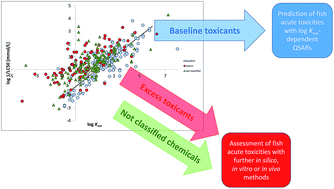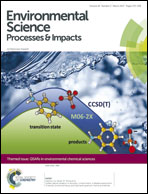Classification of baseline toxicants for QSAR predictions to replace fish acute toxicity studies†
Abstract
Fish acute toxicity studies are required for environmental hazard and risk assessment of chemicals by national and international legislations such as REACH, the regulations of plant protection products and biocidal products, or the GHS (globally harmonised system) for classification and labelling of chemicals. Alternative methods like QSARs (quantitative structure–activity relationships) can replace many ecotoxicity tests. However, complete substitution of in vivo animal tests by in silico methods may not be realistic. For the so-called baseline toxicants, it is possible to predict the fish acute toxicity with sufficient accuracy from log Kow and, hence, valid QSARs can replace in vivo testing. In contrast, excess toxicants and chemicals not reliably classified as baseline toxicants require further in silico, in vitro or in vivo assessments. Thus, the critical task is to discriminate between baseline and excess toxicants. For fish acute toxicity, we derived a scheme based on structural alerts and physicochemical property thresholds to classify chemicals as either baseline toxicants (=predictable by QSARs) or as potential excess toxicants (=not predictable by baseline QSARs). The step-wise approach identifies baseline toxicants (true negatives) in a precautionary way to avoid false negative predictions. Therefore, a certain fraction of false positives can be tolerated, i.e. baseline toxicants without specific effects that may be tested instead of predicted. Application of the classification scheme to a new heterogeneous dataset for diverse fish species results in 40% baseline toxicants, 24% excess toxicants and 36% compounds not classified. Thus, we can conclude that replacing about half of the fish acute toxicity tests by QSAR predictions is realistic to be achieved in the short-term. The long-term goals are classification criteria also for further groups of toxicants and to replace as many in vivo fish acute toxicity tests as possible with valid QSAR predictions.

- This article is part of the themed collection: QSARs and computational chemistry methods in environmental chemical sciences


 Please wait while we load your content...
Please wait while we load your content...